Koulourakia (Κουλουράκια)
Koulourakia (Κουλουράκια) are a traditional Greek cookie perfect for dunking into coffee, tea or milk! This is the classic recipe that uses baking ammonia to help the cookies rise. The result is a cookie that is crispy on the outside but soft on the inside. These cookies need a few simple ingredients and make wonderful gifts. Everyone loves Greek koulourakia.
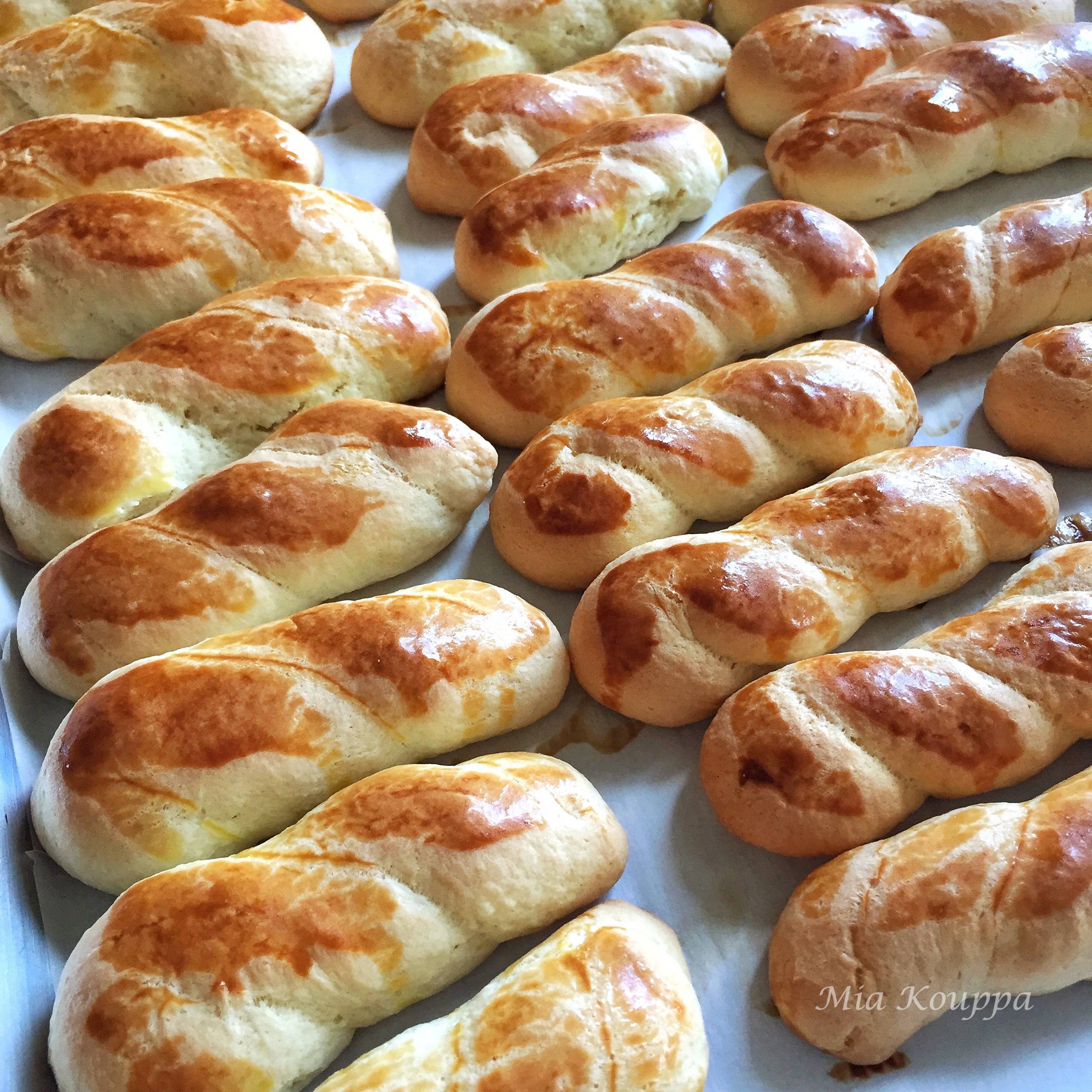
There are many different versions of koulourakia, and there are several on this website, like easy 5 ingredient koulourakia, nistisima (lenten) koulourakia with orange and more. This recipe however is the classic. The original. The one that we automatically think of when we say koulourakia. I hope you give this recipe a try – I truly believe it will be loved by everyone who tries them.
Why this recipe works, and why I love it
When my girls and Billie’s girls were little and we each returned to work after blissfully long (but not long enough!), maternity leaves, we were blessed to have them cared for by our parents. We would drop sleepy children off at their place in the morning and, after settling in to work, we would call our parents to make sure everything was okay. The morning report we received would often go something like this:
Either of our parents: She (grand-daughter # 1, 2, 3 or 4) wasn’t that hungry for breakfast. I hope she is feeling well. I’m quite worried. She only ate half her egg, two pieces of toast, a banana and she only drank one glass of milk.
Either of us: Hmmm…well, that sounds alright. She IS only 4 years old.
Either of our parents: Yes, well she has to eat, otherwise her stomach will close (this sounds much more ominous in Greek). At least she ate 9 koulourakia when she first arrived.
If you try these cookies, you will understand our girls; these koulourakia are borderline addictive. Although there are many Greek cookies, and many variations of what are collectively referred to as koulourakia, we like this recipe because it is simple, and sometimes, simple is nice. This is a traditional Easter cookie baked to help celebrate the end of lent, and the arrival of spring. These cookies are firm on the outside, but soft and almost cake-like on the inside; a substantive cookie that keeps well, especially stored in the fridge. They are perfect as a school or work snack, a late night nibble, and of course, as a pre-breakfast breakfast.
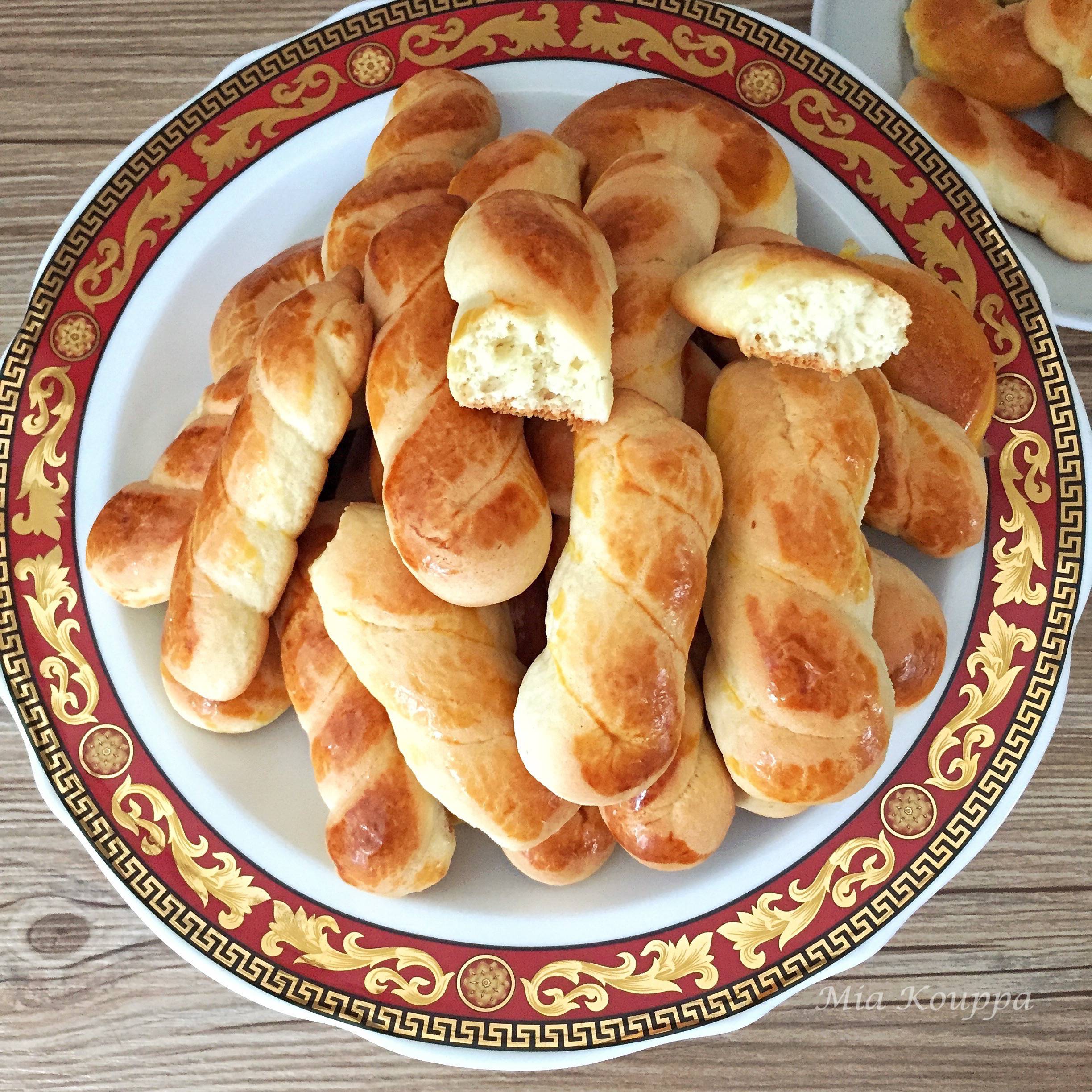
Baking tips and helpful hints
How many koulourakia should you bake?
The original recipe posted makes a LOT of koulourakia (between 120-130 depending on the size). Since some of you don’t want to make quite so many, you can half the recipe. (NOTE (April 2021): we have actually halved the recipe for you. We have added a 2nd recipe box, making a more manageable 60-70 cookies; however we have left the original recipe as well) Permit us to suggest however, that instead of making fewer koulourakia, gather a few families and make an event out of it. Because making koulourakia takes several hours, the company and extra hands will be welcome, and it is a wonderful way to get children involved in the kitchen. At the end of your lovely time together, the families can split the cookies. You can, of course, decide to make the complete batch yourself.
How to shape koulourakia
There are many ways to shape koulourakia, some traditional and others more original. Choose what you like! Encourage your kids to make whatever they think looks beautiful! Experiment! Our only advice would be to try and keep each tray of cookies similar in the size to one another, so that they bake evenly.
Koulourakia expand as they bake!
These koulourakia will get larger as they bake. For this reason, leave at least 1/2 inch of space between cookies on the cookie tray.
How to know if you have added enough flour
If you’re not sure if you need to add more flour to your dough (see the recipe), bake a few koulourakia as a sample. If they flatten out too much, then you need to add a little more flour, perhaps 1/4 cup-1/2 cup to start.
Key ingredients
All purpose flour – Also called regular or plain flour, this is a medium gluten white flour that is used in all sorts of baking. It has about 75% of the wheat grain with most of the wheat germ and bran removed.
Eggs – I always use large eggs in my recipes (unless indicated otherwise). The eggs are used in two ways in the recipe; they are used in the koulouraki batter and also to make an egg wash that is brushed onto the cookies before they back. The egg wash gives the cookies a nice colour and flavour on the top.
Vegetable shortening – This is the fat that is use din these koulourakia. Vegetable shortening is a vegetable oil that has gone through the process of hydrogenation which transforms it into a solid. It is typically white and is much easier to spread than butter is.
Sugar – The koulourakia are sweetened with plain white granulated sugar.
Milk – The liquid used is milk. You can use any dairy milk you like; I tend to use lactose-free milk, but you definitely don’t have to. You will also use a little bit of milk in the egg wash.
Ammonium carbonate – This is an old fashioned leavening agent that really gives these koulourakia their wonderful texture and flavour. When baking with ammonium carbonate you may be surprised by the very strong odour – don’t worry, that smell disappears once the cookies are baked.
Baking powder – Despite using ammonium carbonate, these koulourakia also use baking powder as an additional leavening agent.
Vanilla powder – I use vanilla powder in this recipe because I find it more traditional. It is always what my parents used, so I stick to the way they make it.
How to make
Making koulourakia is so much fun. Honestly, I love the process of preparing the dough and then taking my time to shape the cookies. When the house fills with the smell of them baking, I am in my happy place!
Directions
Step 1
Melt the vegetable shortening in a small saucepan, or even in the microwave. Set aside to cool slightly.
Step 2
In the bowl of an electric mixer fitted with the whisk attachment, beat the egg whites for approximately 5 minutes over medium speed. Continue to beat until they are very fluffy.
Step 3
To the egg whites, with the mixer still working, add the 6 egg yolks, a few at a time. Continue to beat for approximately 3 – 5 more minutes. Periodically, using a rubber spatula, push down any of the egg which has found its way onto the side of the mixing bowl.
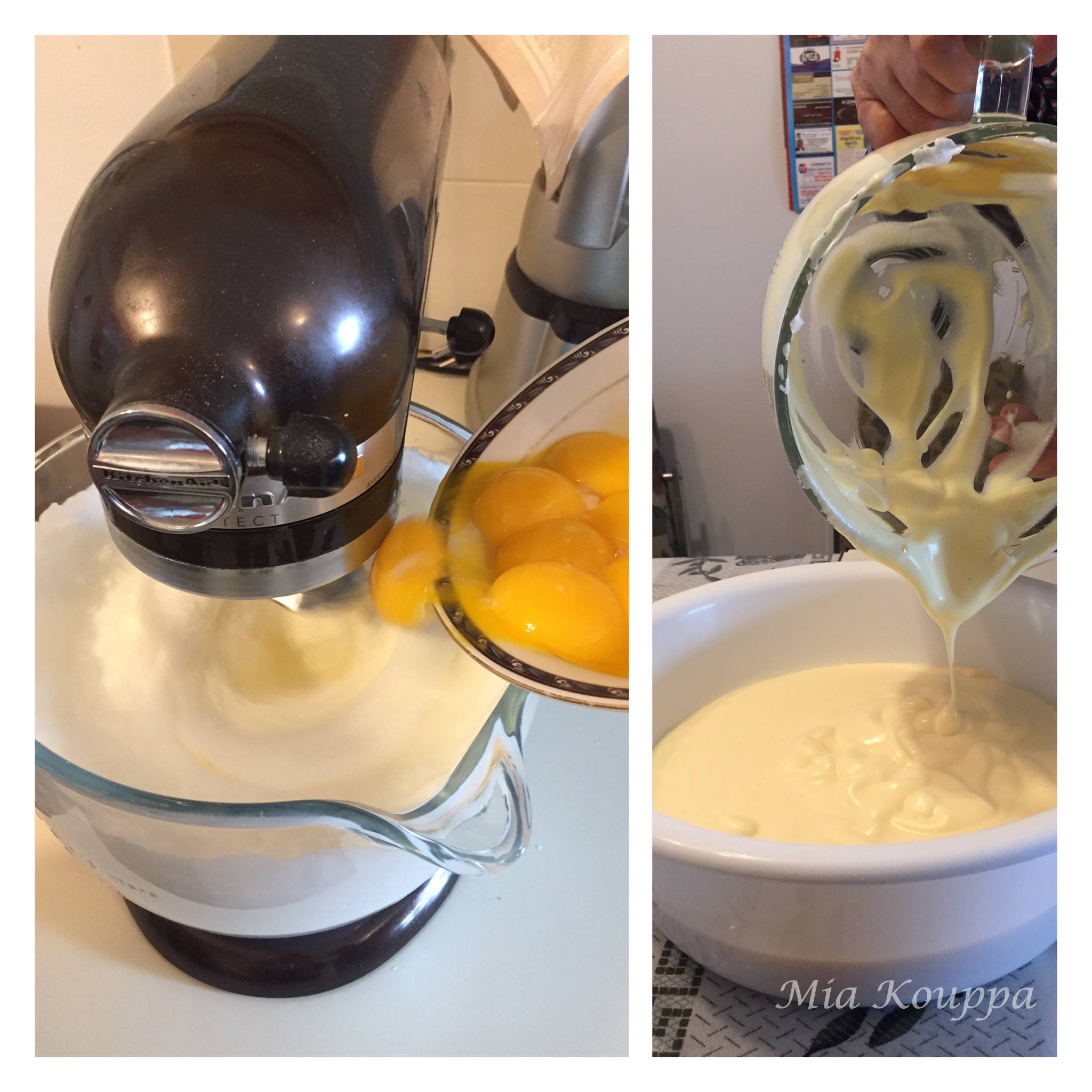
Step 4
When well incorporated, pour the beaten eggs into a very large bowl. Wash out the bowl of the mixer and add the melted vegetable shortening. Beat over medium speed for about 3 minutes. Slowly add in the granulated sugar. Continue to beat well over medium speed.
Step 5
Meanwhile, in a small saucepan mix together the milk and the ammonium carbonate. On medium heat, stir continuously with a whisk, until the milk looks like it is going to bubble over (approximately 5 minutes). At this point, pour the milk + ammonium mixture carefully into the mixing bowl which contains the vegetable shortening and sugar. Turn off the mixer while you are making this addition. Stand back…it’s going to smell! Turn mixture back on and whisk together for another 2 – 3 minutes. To this mixing bowl, add 1/2 cup of all purpose flour. Mix well until all ingredients are well combined.

Step 6
In a small bowl combine the baking powder, the vanilla powder and 1/2 cup all purpose flour. Mix well.
Step 7
Now, into the large bowl where you have your eggs you will add the various combinations of ingredients. Add the flour/baking powder/vanilla powder combination. Add the vegetable shortening/sugar/milk combination. Then, add an additional 5 cups of all purpose flour
Step 8
With your hands, mix all ingredients well. You are almost massaging the ingredients together to incorporate everything. After mixing everything together add an additional 1 cup of all purpose flour. You should get to the point where you can knead the dough in the bowl.
Step 9
You may need to add 1/4 – 1/2 cup more flour if your dough is still wet. Keep in mind that the dough for the koulourakia will be sticky. Cover the dough with a clean kitchen towel and set aside for 15 – 20 minutes. This period of rest will allow the dough to “stiffen” up a bit, making it easier to work with. If you’re not sure if you need to add more flour, bake a few as a sample, if they flatten out too much, then you need to add a little more flour, perhaps 1/4 cup-1/2 cup
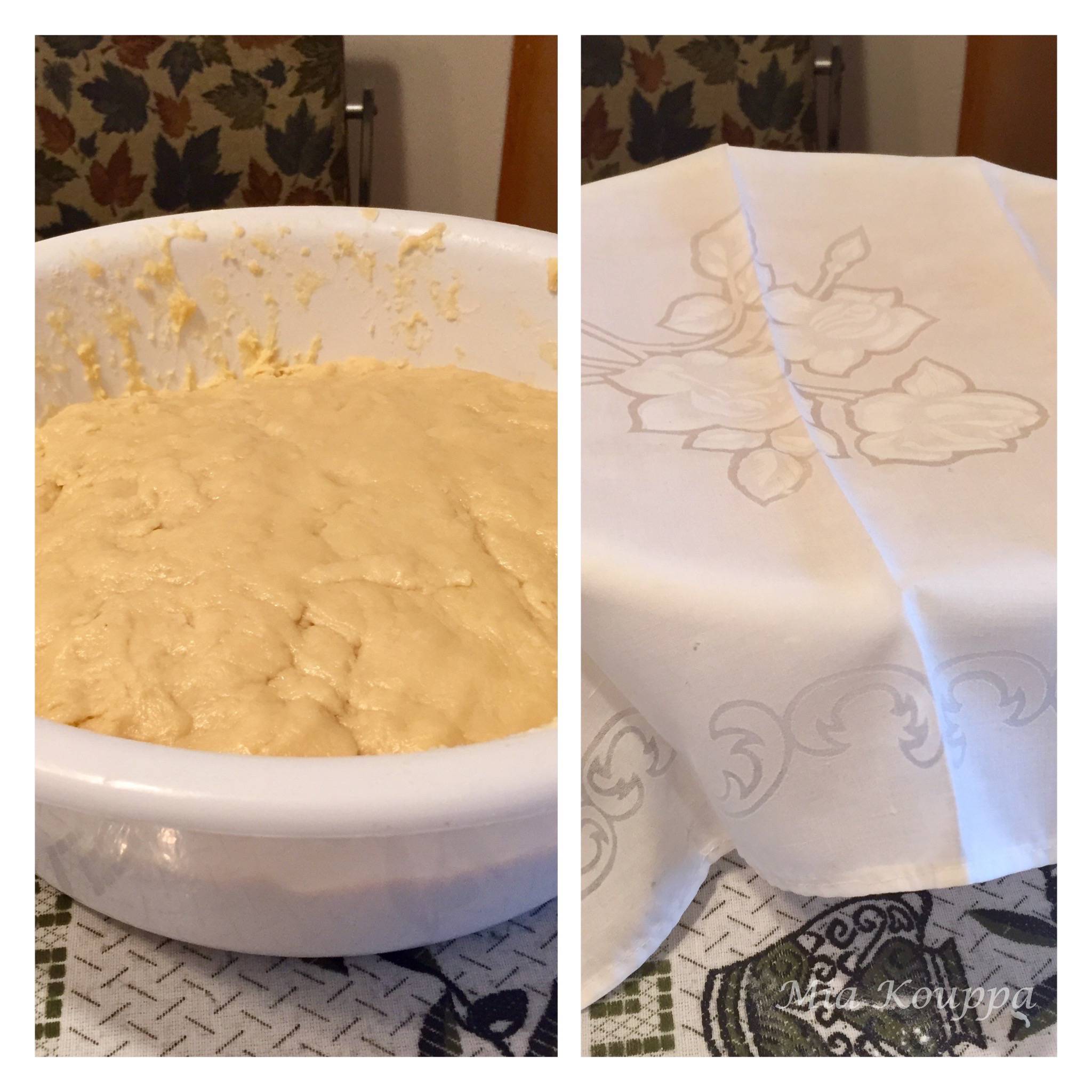
Step 10
Line your baking sheets with parchment paper. Preheat your oven to 400 degrees Fahrenheit.
Step 11
Start forming your koulourakia. Take a small piece of dough (about the size of a walnut) and roll it into a long strip. Fold this strip in half and then twist the two halves together. This makes the traditional twisted shape. Alternatively, you can make a circle with your long strip. You can also make any kind of shape you like, so long as they are all pretty much the same size. You can watch a video here.
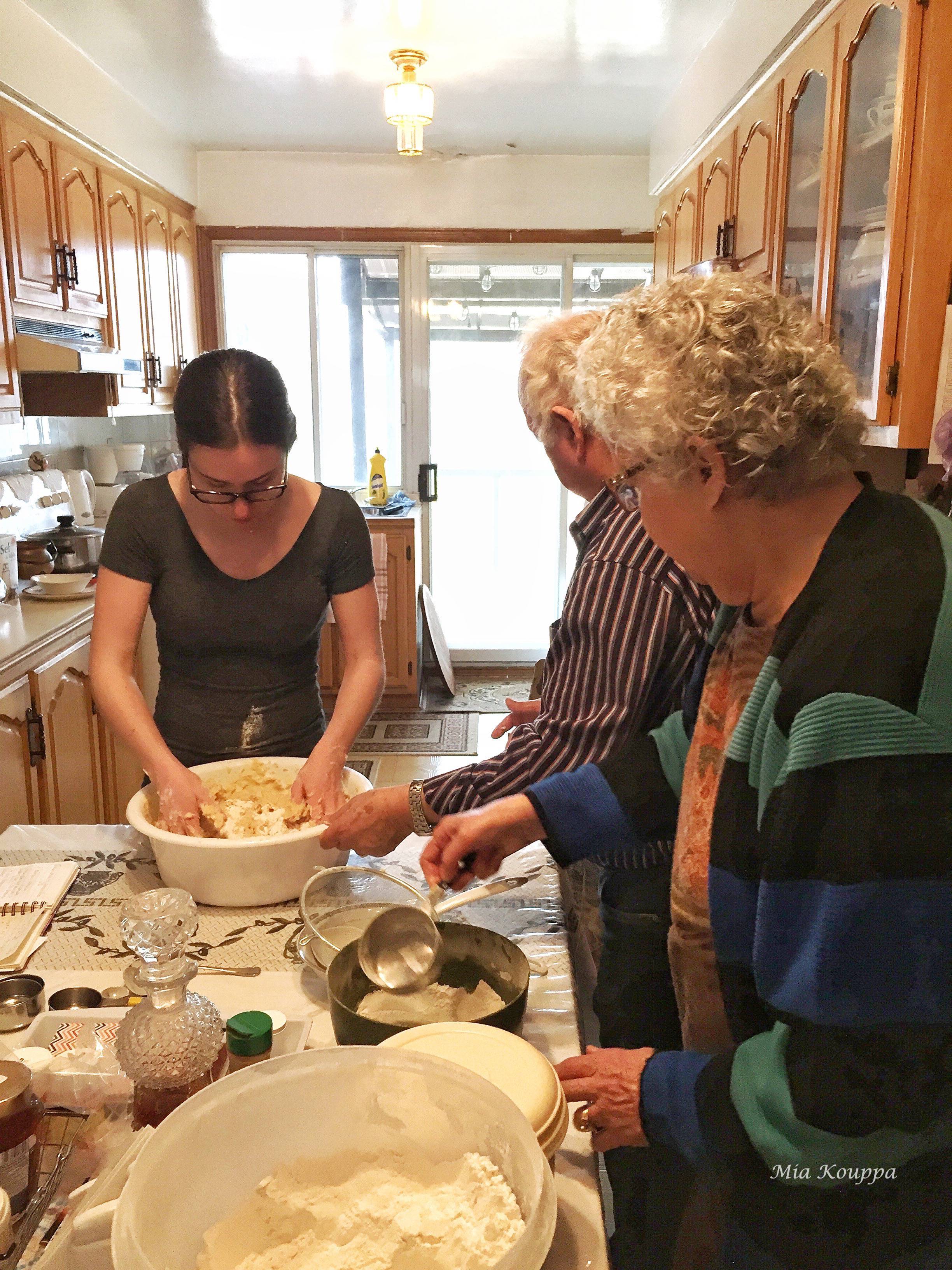
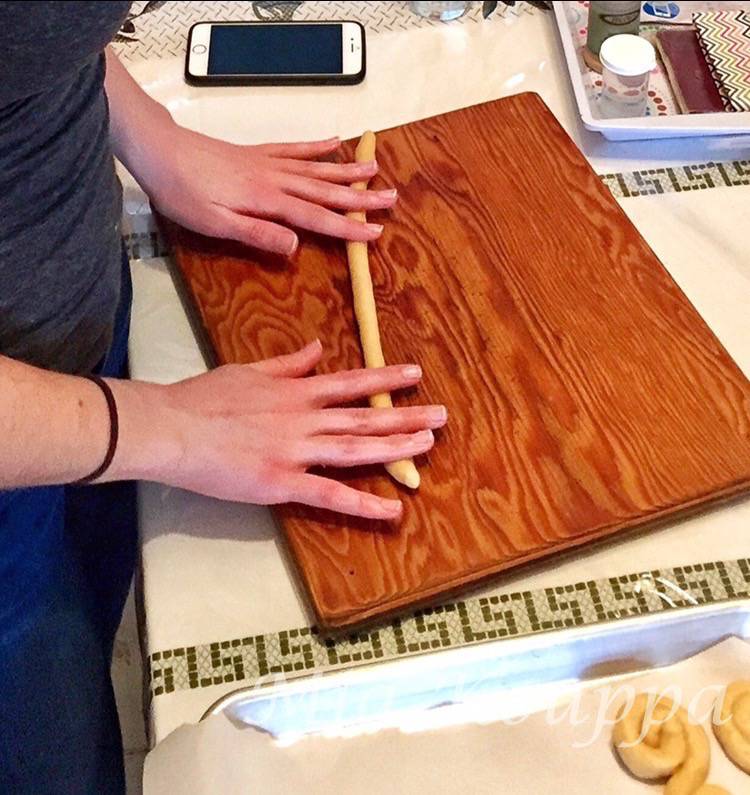
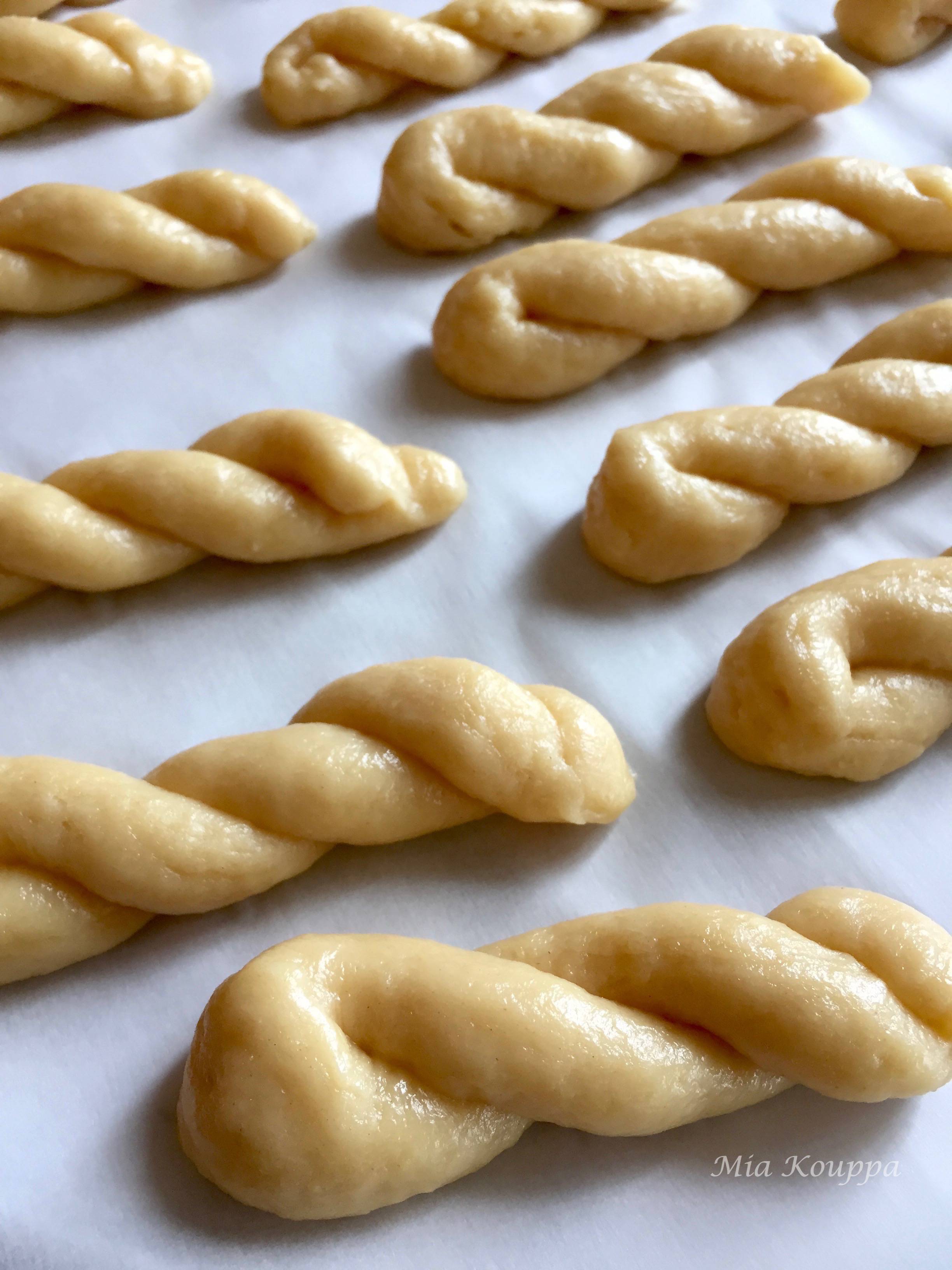
Step 12
Prepare your egg wash by mixing together 2 egg yolks, milk and water. Brush on top of each koulouraki.
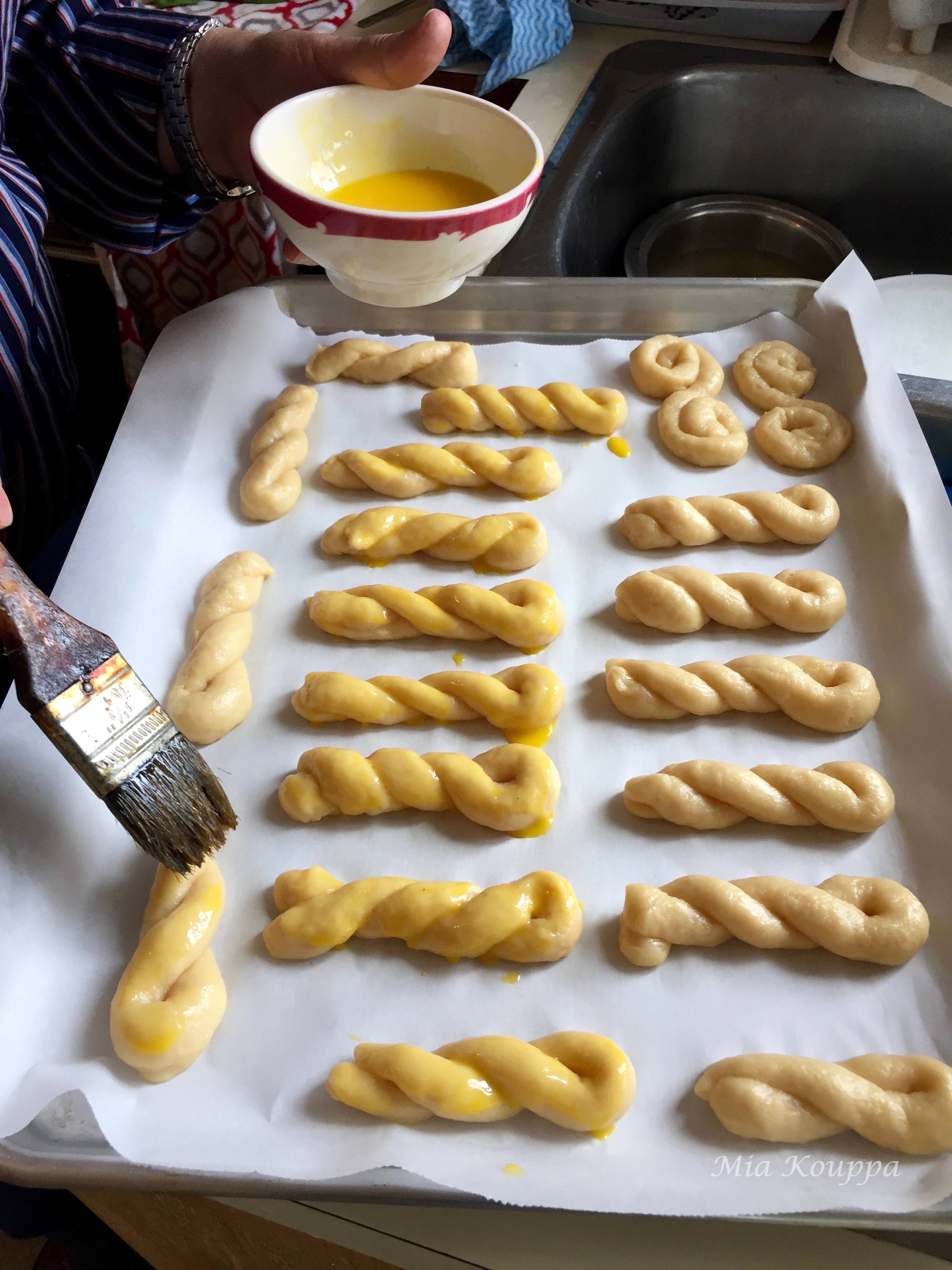
Step 13
Bake in top third of the oven for 20 – 25 minutes (or mid rack, for 14-18 minutes) until a beautiful golden colour.
Recipe substitutions
Ammonium carbonate versus baking powder
If you prefer not to use ammonium carbonate in these cookies, or simply can’t find it, the general rule of thumb is to substitute any quantity of ammonium carbonate with twice as much baking powder. So, in the recipe below, you would replace the 2 tablespoons of ammonium carbonate with 4 tablespoons of baking powder. You would also still add the original 4 tablespoons baking powder the recipe calls for (so, a total of 8 tablespoons baking powder). Yes…this is A LOT of baking powder, but remember…this is A LOT of cookies which are meant to puff up and be quite soft and fluffy in the center.
What is vegetable shortening? Are there substitutions?
It has also come to our attention, from one of our Australian followers, that vegetable shortening is not readily available throughout the world (at least, not in Australia). There are substitutes you can use however and we found this link which is really quite helpful. The most obvious substitution for our Aussie friends is something called copha! (Us Canadians have never heard of copha…but it appears to be very similar to what we know as vegetable shortening, and it is readily available in Australia).
Vanilla extract instead of vanilla powder
If you can’t find vanilla powder, or simply prefer not to use it, then you can definitely use vanilla extract instead. Use 2x the amount of extract. (for example, if a recipe calls for 1 teaspoon of vanilla powder, use 2 teaspoons of vanilla extract).
Storing and freezing
How to store koulourakia
Although koulourakia can be left in a covered container at room temperature for a few days, after that you can keep any extras in the refrigerator where they will stay fresh for a long time. To keep them even fresher, for a longer period of time, you can freeze your baked koulourakia.
How to serve
Best way to eat koulourakia
I think that the best way to eat koulourakia is with something to dunk them into. Whether it is Greek coffee, xeno non-Greek coffee, tea or milk, this is the perfect dunking cookie.
Pin this recipe if you like it!
This recipe for classic Greek koulourakia uses a lot of eggs! Because it makes a lot of cookies!
In the ingredient list below you will see eggs listed twice; this is not a mistake. You will use a total of 15 egg whites and 12 eggs yolks in your koulouraki dough. The remaining 3 egg yolks are used for the egg wash. This way, you waste no part of any egg. Waste is bad! We heard this often growing up…we still do.
NOTE: When you halve the recipe, you will use a total of 8 eggs (8 egg whites, and 6 egg yolks in your koulouraki dough. The remaining 2 egg yolks are used for the egg wash.) This is also explained in the Recipe box below.
Frequently asked questions
What is ammonium carbonate?
This recipe calls for ammonium carbonate. If you have never baked with ammonium carbonate, here are some things you may like to know. Ammonium carbonate is used in baking as a leavening agent, and was very popular before modern day baking powder was made available. It does have a very strong odour, which you will notice particularly when you add the milk and ammonia mixture to the melted vegetable shortening. Don’t worry, the smell will dissipate.
How to separate egg whites from egg yolks
Separating eggs can sometimes be difficult, and there are many different techniques for doing so. There are even egg-separating gadgets that you can buy. I find that one of the easiest ways to separate the yolks and the whites is to use your hands. Crack an egg, pour it into your hand and allow the whites to slip into a bowl between your fingers.
What kind of milk is used in this traditional Greek koulourakia recipe?
My parents make their koulourakia with 2% lactose-free milk for those of us in the family who are lactose intolerant. However, you can also use full lactose milk, full fat milk, 1 % milk, or probably any other type of milk you have lying around. Hmmm…. I wonder what would happen if you used chocolate milk!! Try it…and let me know 🙂
Vanilla powder versus vanilla extract
My parents usually use vanilla powder in their baking instead of vanilla extract, so I have done the same thing here. If you cannot find vanilla powder, simply substitute an equal amount of vanilla extract and add it to the melted vegetable shortening while it is in the mixer.
Looking for more cookie recipes, try these:
Pear-shaped cookies (ahladakia)
Christmas Koulourakia with yeast
Koulourakia with orange
Things you might need:
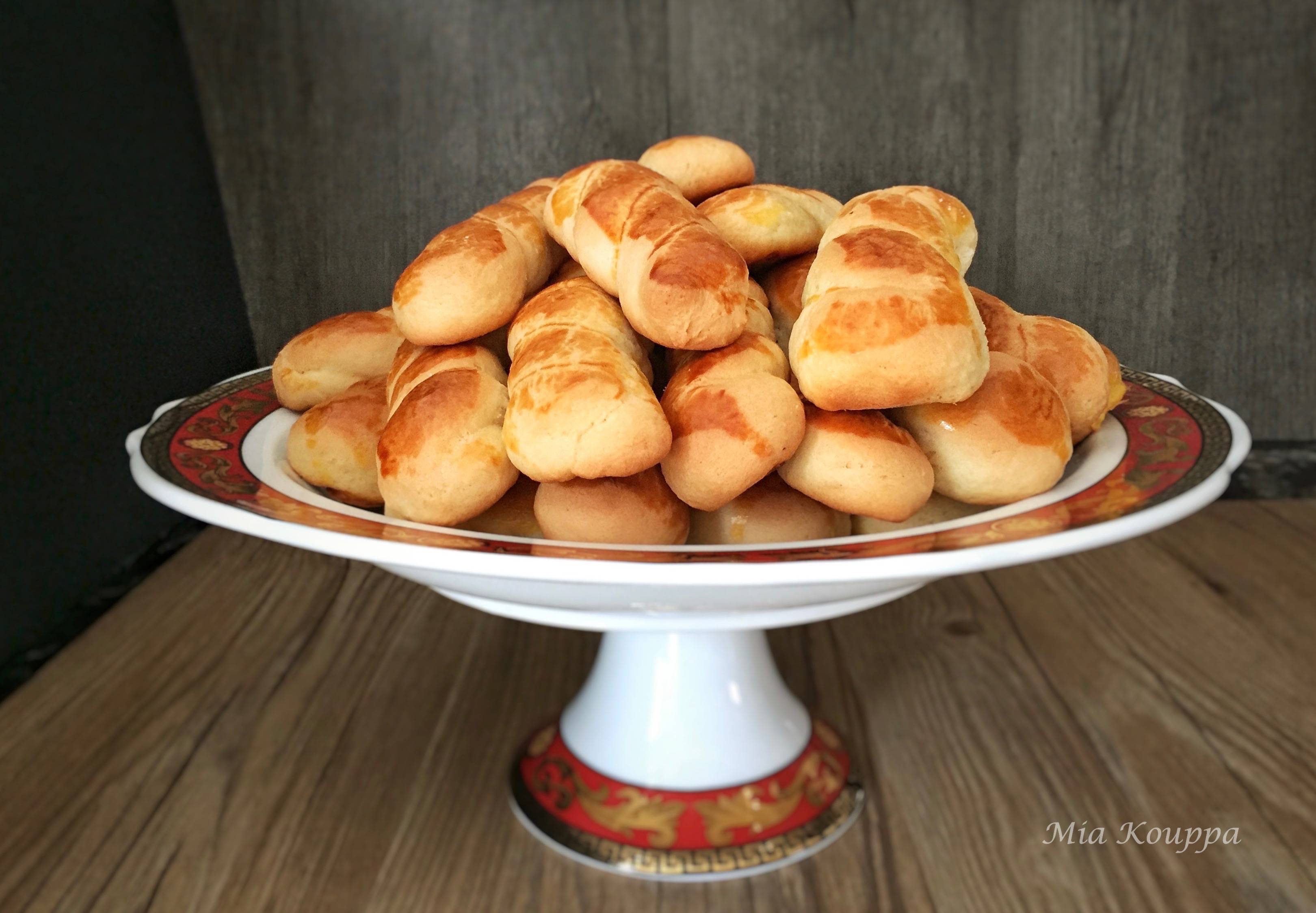
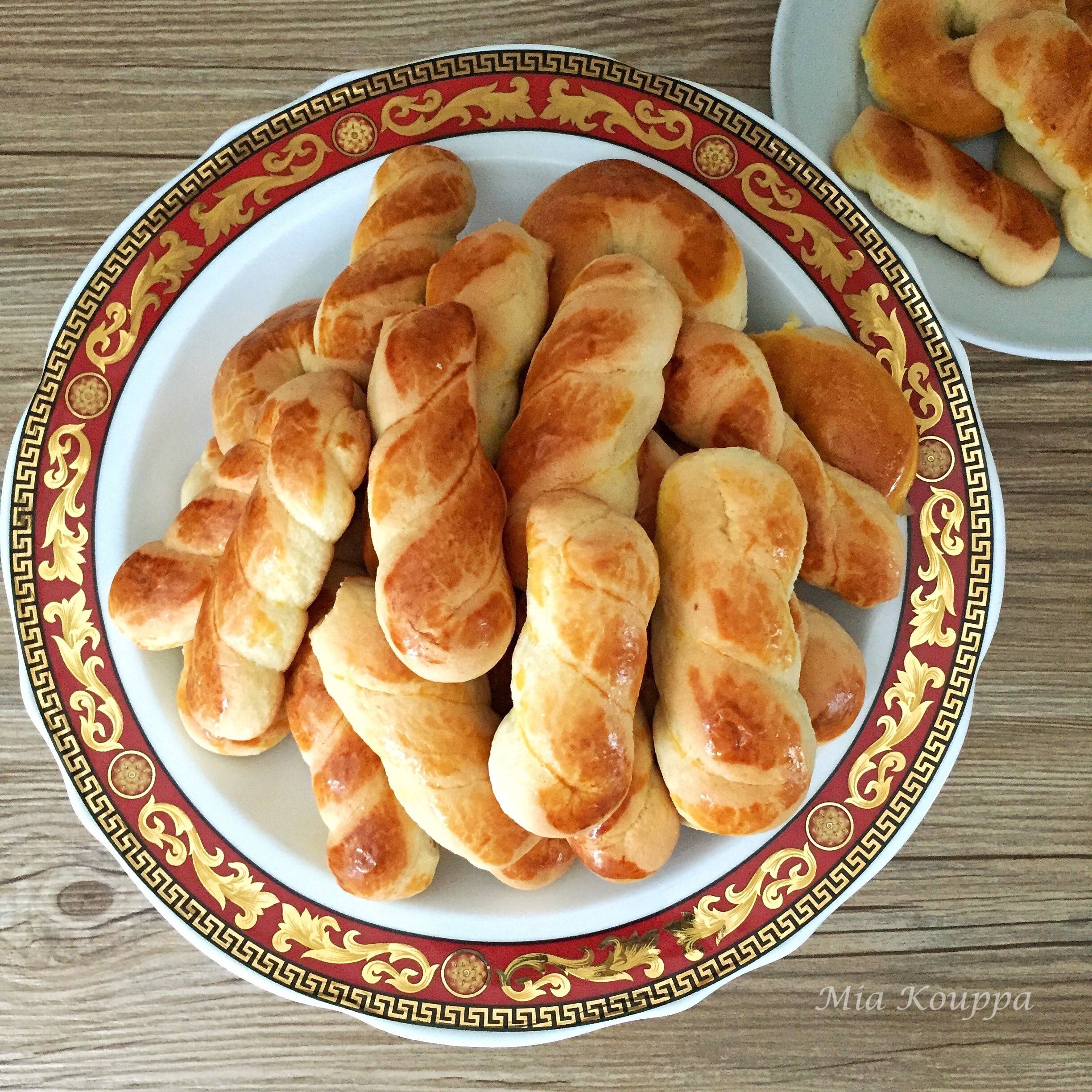
There are 2 recipe boxes below. The first one makes 60-70 cookies. The second box makes 120-130 cookies.
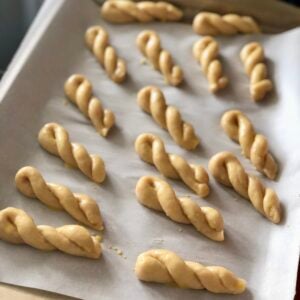
Ingredients
- 6 eggs, separated
- 2 eggs, separated (the whites will be used for the koulouraki dough, the 2 yolks will be used for the egg wash (see below)
- 1/2 lb (227 grams) vegetable shortening
- 1 1/2 cups (300 grams) granulated sugar
- 1 cup (250 mL) milk
- 1 tablespoon ammonium carbonate
- 2 tablespoons baking powder
- 1/2 teaspoon vanilla powder
- 7 cups (1,050 grams) All-purpose flour
For the egg wash
- 2 egg yolks
- 1/2 tablespoon milk
- 1/2 tablespoon water
Instructions
- Always a good idea to read the Helpful Hints, above.
- Melt the vegetable shortening in a small saucepan, or even in the microwave. Set aside to cool slightly.
- In the bowl of an electric mixer fitted with the whisk attachment, beat all 8 egg whites for approximately 5 minutes over medium speed. Continue to beat until they are very fluffy.
- To the egg whites, with the mixer still working, add the 6 egg yolks, a few at a time. Continue to beat for approximately 3 – 5 more minutes. Periodically, using a rubber spatula, push down any of the egg which has found its way onto the side of the mixing bowl.
- When well incorporated, pour the beaten eggs into a very large bowl. Wash out the bowl of the mixer and add the melted vegetable shortening. Beat over medium speed for about 3 minutes. Slowly add in the granulated sugar. Continue to beat well over medium speed.
- Meanwhile, in a small saucepan mix together the milk and the ammonium carbonate. On medium heat, stir continuously with a whisk, until the milk looks like it is going to bubble over (approximately 5 minutes). At this point, pour the milk + ammonium mixture carefully into the mixing bowl which contains the vegetable shortening and sugar. Turn off the mixer while you are making this addition. Stand back…it’s going to smell! Turn mixture back on and whisk together for another 2 – 3 minutes. To this mixing bowl, add 1/2 cup of all purpose flour. Mix well until all ingredients are well combined.
- In a small bowl combine the baking powder, the vanilla powder and 1/2 cup all purpose flour. Mix well.
- Now, into the large bowl where you have your eggs you will add the various combinations of ingredients. Add the flour/baking powder/vanilla powder combination. Add the vegetable shortening/sugar/milk combination. Then, add an additional 5 cups of all purpose flour
- With your hands, mix all ingredients well. You are almost massaging the ingredients together to incorporate everything. After mixing everything together add an additional 1 cup of all purpose flour. You should get to the point where you can knead the dough in the bowl.
- You may need to add 1/4 – 1/2 cup more flour if your dough is still wet. Keep in mind that the dough for the koulourakia will be sticky. Cover the dough with a clean kitchen towel and set aside for 15 – 20 minutes. This period of rest will allow the dough to “stiffen” up a bit, making it easier to work with. If you’re not sure if you need to add more flour, bake a few as a sample, if they flatten out too much, then you need to add a little more flour, perhaps 1/4 cup-1/2 cup
- Line your baking sheets with parchment paper. Preheat your oven to 400 degrees Fahrenheit.
- Start forming your koulourakia. Take a small piece of dough (about the size of a walnut, about 25-27 grams) and roll it into a long strip. Fold this strip in half and then twist the two halves together. This makes the traditional twisted shape. Alternatively, you can make a circle with your long strip. You can also make any kind of shape you like, so long as they are all pretty much the same size. You can watch a video here.
- Prepare your egg wash by mixing together the 2 egg yolks, milk and water. Brush on top of each koulouraki.
- Bake in top third of the oven for 20 – 25 minutes (or mid rack, for 14-18 minutes) until a beautiful golden colour.
- Enjoy!
Notes
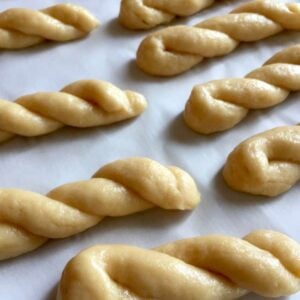
Koulourakia (large quantity)
Ingredients
- 12 eggs, separated
- 3 eggs, separated (the whites will be used for the koulourakia dough, the yolks to be used for egg wash)
- 1 pound (454 grams) vegetable shortening
- 3 cups (600 grams) granulated sugar
- 2 cups (500 mL) milk
- 2 tbsp ammonium carbonate
- 4 tbsp baking powder
- 1 teaspoon vanilla powder
- 14 cups (2,100 grams) sifted all-purpose flour
For the egg wash:
- 3 egg yolks
- 1 tbsp milk
- 1 tbsp water
Instructions
- Always a good idea to read the Helpful Hints, above.
- Melt the vegetable shortening in a small saucepan, or even in the microwave. Set aside to cool slightly.
- In the bowl of an electric mixer fitted with the whisk attachment, beat all 15 egg whites for approximately 5 minutes over medium speed. Continue to beat until they are very fluffy.
- To the egg whites, with the mixer still working, add the 12 egg yolks, a few at a time. Continue to beat for approximately 3 – 5 more minutes. Periodically, using a rubber spatula, push down any of the egg which has found its way onto the side of the mixing bowl.
- When well incorporated, pour the beaten eggs into a very large bowl. Wash out the bowl of the mixer and add the melted vegetable shortening. Beat over medium speed for about 3 minutes. Slowly add in the granulated sugar. Continue to beat well over medium speed.
- Meanwhile, in a small saucepan mix together the milk and the ammonium carbonate. On medium heat, stir continuously with a whisk, until the milk looks like it is going to bubble over (approximately 5 minutes). At this point, pour the milk + ammonium mixture carefully into the mixing bowl which contains the vegetable shortening and sugar. Turn off the mixer while you are making this addition. Stand back…it’s going to smell! Turn mixture back on and whisk together for another 2 – 3 minutes. To this mixing bowl, add 1 cup of all purpose flour. Mix well until all ingredients are well combined.
- In a small bowl combine the baking powder, the vanilla powder and 1 cup all purpose flour. Mix well.
- Now, into the large bowl where you have your eggs you will add the various combinations of ingredients. Add the flour/baking powder/vanilla powder combination. Add the vegetable shortening/sugar/milk combination. Then, add an additional 11 cups of all purpose flour.
- With your hands, mix all ingredients well. You are almost massaging the ingredients together to incorporate everything. After mixing everything together add an additional 1 cup of all purpose flour. You should get to the point where you can knead the dough in the bowl.
- You may need to add 1/4 – 1/2 cup more flour if your dough is still wet. Keep in mind that the dough for the koulourakia will be sticky. Cover the dough with a clean kitchen towel and set aside for 15 – 20 minutes. This period of rest will allow the dough to “stiffen” up a bit, making it easier to work with. If you’re not sure if you need to add more flour, bake a few as a sample, if they flatten out too much, then you need to add a little more flour, perhaps 1/4 cup-1/2 cup.
- Line your baking sheets with parchment paper. Preheat your oven to 400 degrees Fahrenheit.
- Start forming your koulourakia. Take a small piece of dough (about the size of a walnut, about 25-27 grams) and roll it into a long strip. Fold this strip in half and then twist the two halves together. This makes the traditional twisted shape. Alternatively, you can make a circle with your long strip. You can also make any kind of shape you like, so long as they are all pretty much the same size. You can watch a video here.
- Prepare your egg wash by mixing together the 3 egg yolks, milk and water. Brush on top of each koulouraki.
- Bake in top third of the oven for 20 – 25 minutes (or mid rack, for 14-18 minutes) until a beautiful golden colour. Let rest a couple of minutes on the baking pan, then transfer them to a wire rack to cool.
- Enjoy!

Looks rustic and amazing 🙂
Is it necessary to use Ammonia? I would like to make them without ammonia.
Hi Cleo. Ammonia does sound ominous doesn’t it!…and sometimes it is not so easy to find (depending on where you live). Actually, you can substitute ammonia for more baking powder. The basic rule of thumb is to use double amount of commercial baking powder as you would ammonia…so if a recipe calls for 2 tablespoons ammonia, use 4 tablespoons baking powder. In this koulourakia recipe you would have to use the original baking powder we call for, and then some more to exchange for the ammonia. Hope this helps, and that you enjoy the koulourakia!
I would love to try one!
They are really yummy!
We make these every Easter from a recipe I have from my mother in law. They are delicious!
It’s so amazing to keep family recipes, and traditions, alive! Happy Easter 🙂
You make it look so easy! Looks so good 🙂
Lisa | Travelblog Joy Della Vita
Oh, thank you Lisa 🙂 They are actually pretty easy…a bit time consuming, but simple. Let us know if you ever try them. Dunked in coffee, tea or milk, they are delicious 😉
I’m more interested in the beautiful dish shown! Can you tell me where and if I can purchase
🙂 The dish is beautiful isn’t it?! Unfortunately, I can’t tell you where it was purchased. It was a gift…from quite a while ago!
This makes roughly how many plz
Wow just saw it 120-130
Yes! It’s quite a production…but rest assured, you can easily half the recipe. 🙂
Can butter be substituted for vegetable shortening. If not, which brand of vegetable shortening works well with this recipe. Thank you!! Merry Christmas!!!
Hi Helen! Merry Christmas to you! We use Crisco vegetable shortening in this recipe. Although you can probably substitute butter for the shortening, the quantity might not be exactly the same. Our parents do make another version of koulourakia with butter however, and we will be posting that recipe as well at some point. Thanks for your interest in Mia Kouppa!
Thank you! I will be using butter and a flavorless vegetable oil like safflower…Thank you for pointing out how to tweak the flour required in this recipe!!! Happy New Year!!! <3
You’re welcome! Would love to hear how they turn out 🙂 Happy baking…and Happy New Year!
Great looking Koulourakia. Just noticed your other version made with butter. This is the way we always made them with unsalted butter. We always added either Ouzo, or anise flavor extract. Interesting how different Greek cultures make their own versions. Love your site. Yassou!
Thank you so very much! Yes, we love learning about new regional Greek recipes, and even family variations on classic recipes. Everyone has their own twist, and that it what makes cooking and baking so much fun. Thank you for your kind words 🙂
They look delicious! Thank you for sharing the recipe and so many beautiful pictures!
Thank you so much 🙂
You are more than welcome! 🙂
Loved these when your mom soul send me some to eat ❤️❤️❤️
I do remember Louisa 🙂 My mom still asks about you!! Next time you’re in town we’ll get her to bake you a batch 🙂
Can I sub some of the milk with orange juice. My Greek friend make these with orange juice. Have not been able to replicate her recipe with her great results
What can I use instead of vegetable shortening which I don’t have at the moment and will it really alter the taste?
Hi Sotiria, sorry for the late reply. You can replace the shortening with unsalted butter..use the same amount as the shortening.. the only thing it will alter is the texture, but they’ll still be delicious 🙂
Quick question regarding your koulourakia recipe. If I decide to halve the recipe, I get the 8 egg whites. So would that mean 6 yolks? (plus 2 for the egg wash?) Thanks. BTW simply love your recipes and the stores behind them as well. Funny how we all have some type of similar story. Thanks again.
Hi Connie, thanks for your message. We’re so glad you’re enjoying our recipes and stories. We’re always happy to hear that :).. Yes, if you halve the recipe, use 8 eggs total… 8 egg whites, and 6 egg yolks for the cookies; and 2 egg yolks for the egg wash.. Good luck, and Kali Anastasi!
Hello, I can’t find the version of this recipe that uses unsalted butter. I don’t have crisco shortening and would like to use butter instead but I don’t know how much to put. I am also looking at halving the recipe to make 60-70 pieces. Any help would really be appreciated 🙂
Hi Natalie, you can replace the shortening with butter.. equal amount.. the only thing is, the texture might be a little bit different, but they will still be delicious. The recipe is easily halved. Let us know if you have any questions about it.
Hello,
Thank you so much for this recipe.
I have a question, if I may…
Do these come out more soft and gooey on the inside, like a soft cookie, or do they come out more crumbly dry, like “voutimata” or kourabiethes consistency?
My mother used to make a unique version that was so soft on the inside that it was almost like a tsoureki or a freshly baked croissant. Unfortunately, I never wrote down the recipe, can’t remember it, and she passed before I could ask her for it, so my fingers are crossed!!! 🙂
Thank you!
Kat
Hi Kat. Thank you so much for your comment, and question. These koulourakia are soft on the inside (not bread-like, but soft); they are a perfect coffee, tea or milk dunking cookie, although they are equally great on their own. We are not sure how they will compare to the one’s your mom made (we have a feeling that nothing will be quite as good as hers’), but we hope you find them delicious. Please let us know what you think if you try the recipe. xoxo Helen & Billie
I always used ammonia and they turn out great. Now I’m curious about the Crisco vegetable shortening. How does the texture compare using butter?
Hi there!! First, love your name (avatar?) – are you a nurse? One of us is too! Back to baking, the vegetable shortening really leads to lighter, flakier and fluffier koulourakia; less dense and heavy than butter. Definitely worth a try! xoxo Helen & Billie
Hey! Yes I am a nurse and my name is Helen also! Thanks for the explanation, I’ll give it a shot. Love your recipes!
I made these with my mom today and they are delicious. They are moist inside and not very sweet. This recipe does make a lot of cookies but we’re a big family so that works well for sharing. Thank you!
Hi Amalia!! Thanks for your message. We are so happy that you tried and enjoyed our koulourakia recipe. It is indeed a huge recipe (!). In the future if you prefer you can halve it pretty easily. The koulourakia also freeze well after they are baked if you don’t think you will need them all at the same time. xoxo Helen & Billie